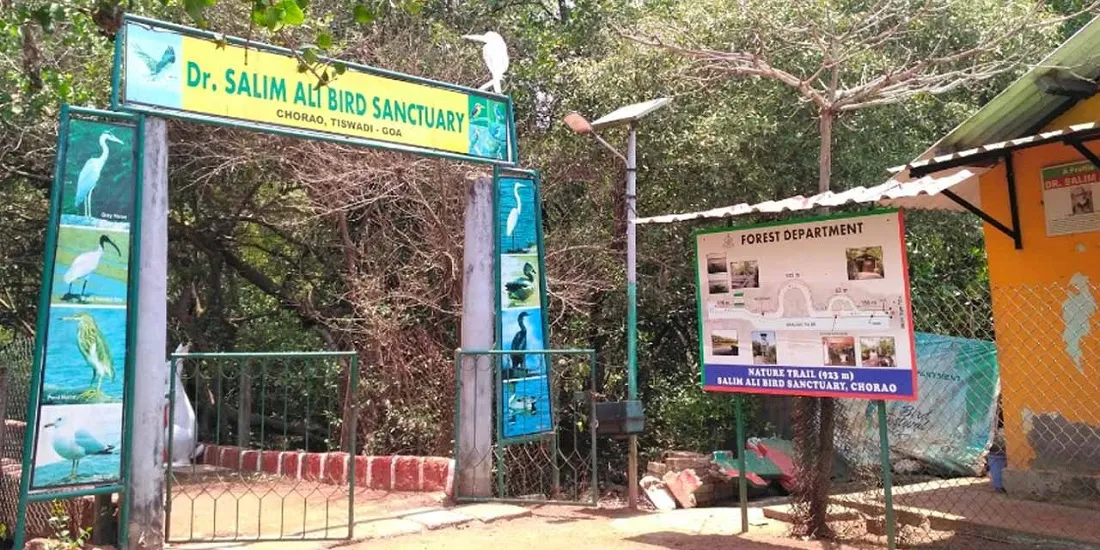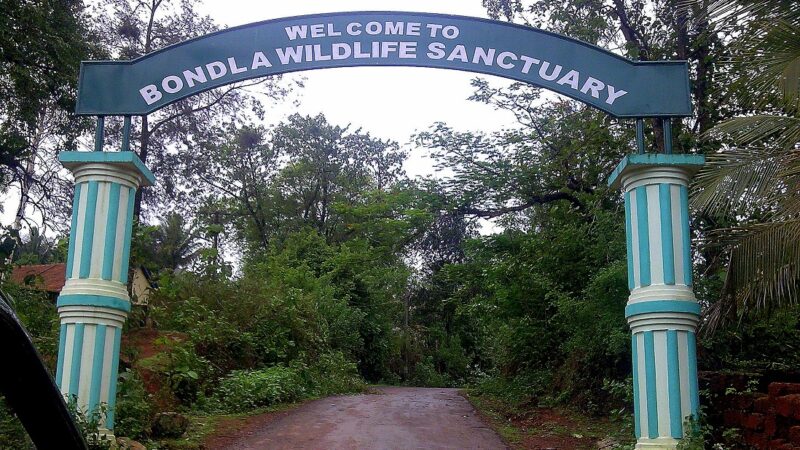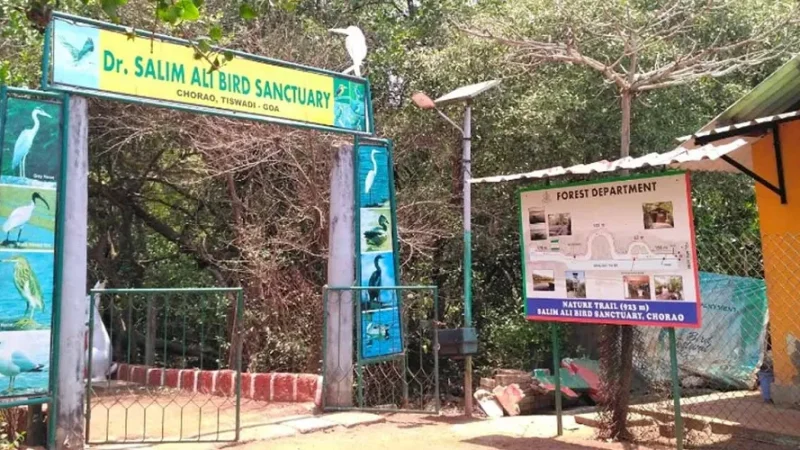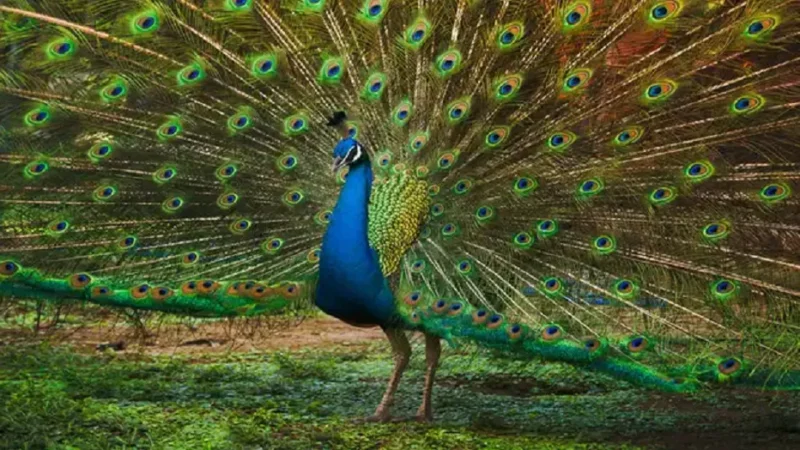Salim Ali Bird Sanctuary in Goa: Entry Fee, Timings, Best time to visit and Birds

Table of Contents
ToggleBird Sanctuary in Goa
Nestled amidst the emerald beauty of Goa, where the river’s gentle whispers meet the symphony of vibrant wings, lies the enchanting Salim Ali Bird Sanctuary. Named in honour of the legendary ornithologist Dr Salim Ali, this Sanctuary is a treasure trove of avian wonders. It’s a place where nature enthusiasts and birdwatchers can lose themselves in a world of colourful plumage and melodic calls. Join us as we embark on a journey to discover the ethereal realm of the Salim Ali Bird Sanctuary, where each step is a glimpse into the captivating lives of our feathered friends.
History of the Sanctuary and its Significance as a Bird Habitat
The Salim Ali Bird Sanctuary is located on the island of Chorao in Goa, India. The Sanctuary is named after Dr. Salim Ali, a renowned Indian ornithologist. The Sanctuary covers an area of 1.4 square kilometers and is home to over 400 species of birds, including both resident and migratory birds.
The area that is now the Salim Ali Bird Sanctuary was once a lush mangrove forest. However, in the early 20th century, the mangroves were cleared to make way for agriculture. This led to a decline in the number of birds in the area.
The Sanctuary was officially established in 1987. Since then, the mangroves have been restored and the number of birds in the area has increased. The Sanctuary is now a popular tourist destination and a valuable resource for birdwatchers and scientists.
Significance as a Bird Habitat
The Salim Ali Bird Sanctuary is an essential habitat for many species of birds. The Sanctuary’s mangrove forest provides food and bird shelter, and the tidal creeks and mudflats provide breeding grounds. The Sanctuary is also an important migration stopover for many species of birds.
Types of Birds found in the Sanctuary
The Salim Ali Bird Sanctuary in Goa is home to over 400 species of birds, including both resident and migratory birds. Here are some of the most common types of birds found in the Sanctuary:
- Herons and egrets: These long-legged, wading birds are common sights in the Sanctuary. They can be seen standing in the shallow water of the creeks and mudflats, looking for fish and other aquatic creatures.
- Sandpipers: These small shorebirds are also common in the Sanctuary. They can be seen running along the mudflats, picking up worms and other small invertebrates.
- Kingfishers: These colourful birds are known for catching fish in mid-air. They can be seen perching on branches overhanging the water, waiting for their prey to come close to the surface.
- Eagles: These large, powerful birds are apex predators in the ecosystem. They can be seen soaring high above the Sanctuary, looking for prey.
- Flamingos: These pink birds are a popular attraction at the Sanctuary. They can be seen wading in the shallow water of the creeks, feeding on algae and other small invertebrates.
- Great hornbill: This large, colorful bird is a symbol of Goa. It is found in the forests of the Sanctuary, and it is an important seed disperser.
- White-bellied sea eagle: This giant eagle is a predator of fish and other aquatic creatures. It is found in the coastal areas of the Sanctuary.
- Indian paradise flycatcher: This small, colourful bird is a common sight in the Sanctuary’s forests. It is known for its long tail and its ability to mimic the calls of other birds.
Best time to visit Salim Ali Bird Sanctuary
Best time to visit the Salim Ali Bird Sanctuary is during the winter months, from October to March. This is when the migratory birds from Central Asia arrive in Goa, and the Sanctuary is teeming with birdlife.
The Sanctuary is open from 6:00 AM to 5:00 PM, and the best time to go birdwatching is in the morning or late afternoon, when the birds are most active.
What to see and do
The Salim Ali Bird Sanctuary is an excellent place for various activities. Here are some of the things you can see and do:
- Birdwatching: The Sanctuary is home to over 400 species of birds, so there is plenty to see. You can hire a guide to help you identify the birds, or you can bring your own binoculars and bird identification guide.
- Boating: You can take a boat ride through the Sanctuary to see the birds and other wildlife up close.
- Photography: The Sanctuary is a great place to take photos of birds, other wildlife, and the scenery.
- Nature walks: There are several nature trails in the Sanctuary that you can take to explore the mangroves and other habitats.
- Visiting the Dr. Salim Ali Interpretation Centre: The centre has exhibits on the birds of Goa, as well as on Dr. Salim Ali’s life and work.
Role of the Salim Ali Bird Sanctuary in conservation
Salim Ali Bird Sanctuary in Goa is vital in conservation efforts for bird species across the region. Established in 1987, the Sanctuary serves as a critical habitat for over 400 species of birds, both resident and migratory. The Sanctuary’s diverse ecosystem, including mangrove forests, tidal creeks, and mudflats, provides essential nesting, breeding, and feeding grounds for these avian populations.
Habitat Protection
The Sanctuary’s management team actively works to protect the mangrove forests and other sensitive habitats within the Sanctuary. This includes efforts to control invasive species, minimize human disturbance, and promote sustainable practices.
Species Monitoring
The Sanctuary conducts regular surveys to monitor bird populations and identify species of conservation concern. This data is used to inform management decisions and prioritize conservation efforts for vulnerable species.
Community Engagement
The Sanctuary involves local communities in conservation efforts through education programs, volunteer opportunities, and livelihood initiatives. This fosters a sense of ownership and responsibility for conservation among residents.
Research Collaboration
The Sanctuary collaborates with researchers from various institutions to conduct studies on bird ecology and conservation. This research contributes to the advancement of knowledge and the development of effective conservation strategies.
How to reach Salim Ali Bird Sanctuary
The Salim Ali Bird Sanctuary is located on Chorao Island in Goa, India, and it can be reached via a combination of land and water transportation. Here’s how to get into the Salim Ali Bird Sanctuary:
Travel to Goa
If you still need to get to Goa, your journey begins by reaching the state. Goa is well-connected by air, rail, and road. You can fly into Goa’s Dabolim Airport or arrive by train at one of the major railway stations in the state, such as Madgaon or Thivim.
Travel to Panaji or Nearby Locations
The Sanctuary is situated on Chorao Island, which is not far from the state capital, Panaji (Panjim). From Panaji, you can proceed to reach the Sanctuary.
From Panaji to Ribandar or Pomburpa (by Road)
- You can hire a taxi, auto-rickshaw, or use your vehicle to reach the Ribandar or Pomburpa ferry point, which is on the mainland.
- From Ribandar or Pomburpa, you’ll need to take a ferry to Chorao Island.
Cross the Mandovi River (by Ferry)
Ferries are available at these points to transport passengers and vehicles across the Mandovi River to Chorao Island. The ferry ride is a short and scenic journey.
Reach Chorao Island (by Ferry)
Once you reach Chorao Island, you can either walk or hire a local mode of transportation (like an auto-rickshaw) to the Salim Ali Bird Sanctuary.
It’s important to note that the availability and schedule of ferries can vary, so it’s a good idea to check the current ferry timings and transportation options with local authorities or residents before planning your visit. Additionally, account for the time needed for the ferry ride and any waiting time at the ferry points.
The journey to the Salim Ali Bird Sanctuary offers a unique experience, allowing you to explore the scenic beauty of Goa’s waterways and natural surroundings before arriving at this birdwatcher’s paradise.




